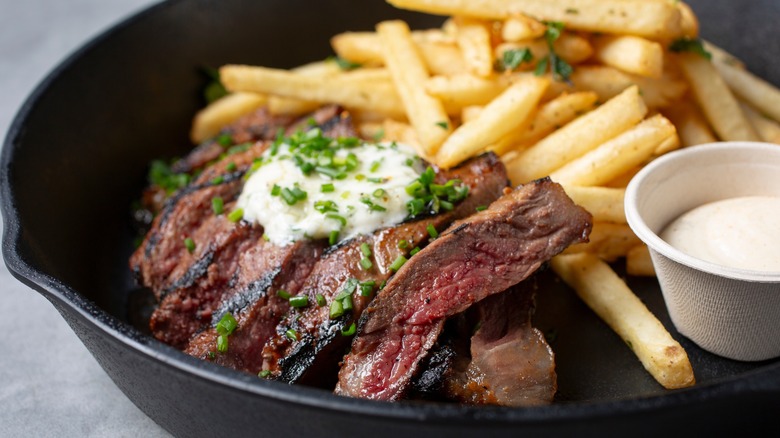The Disputed Origin Of Steak Frites
France and Belgium have often had a contentious relationship, and that extends to the culinary world. Both countries claim ownership of shared dishes — just as Greece and Turkey do over yogurt, and Austria and Slovenia over pork sausages — and history provides enough ambiguity to prevent full clarity. Look no further than the french fry, which Belgium appears to have invented, even if it lost the name claim (thanks to American soldiers). Add a few cuts of steak, a dab of Béarnaise sauce, and a sprinkle of herbs, and the debate erupts again over the origin of this Belgian-French carnivore classic: steak frites.
The passion for the dish is loud and clear on both sides. In France, steak frites is celebrated like a favorite child, and is de rigueur on any decent French menu worldwide. Indeed, part of France's claim to ownership is how it developed the dish into today's beloved version and made it famous. However, Belgium brings equal passion to the debate and claims steak frites among its national dishes, pointing again to its invention of the "frite" in the 17th century. Without that, there's no steak frites. Plus, it probably didn't take long for Belgians of the day to marry the newfangled fried potato strips with a few cuts of meat — and, not to mention, a goblet of Belgian ale for a dinner party.
The best of both worlds
Rather than keeping up the fight, aficionados and enthusiasts of steak frites may find more common ground and compromise on the plate — with nods to both sides' contributions. This starts with the Belgian fry, whose fame has spawned shops around the world dispensing the treat. Belgian fries are traditionally pre-cooked and cooled, then resuscitated with a second dip in the oil when ordered, creating a crispy, golden sheath around a soft, fluffy interior. Their superiority has not only spawned Belgian fry shops worldwide, but has also been adopted by chefs in France and beyond. Belgian fries also tend to be thicker cuts, needing to be at least 10 millimeters on each side to contain enough inside to soften.
On the French side, the Béarnaise sauce so often slathering the typical cuts of rump or hanger steak adds a dose of refinement and flavor. In fact, this staple of French cuisine — a white wine vinegar, shallot, and tarragon reduction thickened with egg yolks and emulsified with clarified butter — is considered a "mother sauce" of French cuisine, and a test for any French chef. The creamy richness also balances the salt and brine of the steak, reinforcing why cream sauces are so often paired with meat dishes. As in so many aspects of cuisine, it's the combination of all these elements and cultures that makes a dish special — steak frites included.

